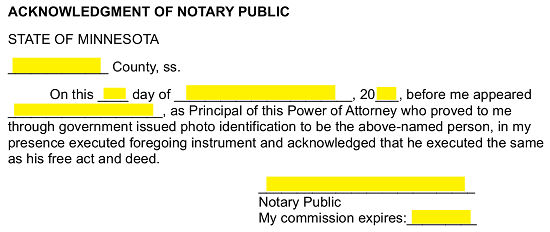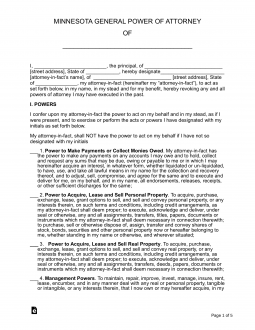Updated August 09, 2023
A Minnesota general (financial) power of attorney form is a document that allows you to appoint a trusted friend or relative to handle your general financial affairs on your behalf. People often use these forms when they anticipate being away or unavailable or just want their spouse to be able to act for them whenever it is convenient. You may not want to, however, use this as a long-term planning tool as it becomes void in the event you can no longer make decisions for yourself. If you are looking for the powers to continue beyond your incapacity, you may want to consider the durable power of attorney instead.
Laws
- Statutes – Chapter 523. Powers of Attorney
- Authority (M.S.A. § 523.23) – An agent under a general power of attorney may act on behalf of the principal and exercise broad authority as granted by the agreement. The purpose of the power of attorney is for the principal to give broad and sweeping powers to your attorney(s)-in-fact, the person designated to handle affairs.
- Signing Requirements (M.S.A. § 523.01 & M.S.A. § 523.23) – Notary Public.
How to Write
Download: PDF, MS Word, OpenDocument
1 – Supply The Title Of This Document With Principal Information
The Full Name of the Principal will need to be entered in the Title of this form. This will designate this form as that of the individual appointing his or her Principal Powers to other individuals (known as Attorney(s)-in-Fact).
2 – Complete The Declaration Statement
The first paragraph of this form will serve as an introductory statement where the Principal announces his or her intentions in delegating Principal Authority to the Attorney(s)-in-Fact. This statement will require the direct attention of the Preparer of this form.
Enter the Principal’s Full Name on the first blank space in this paragraph.  The Residential Street Address where the Principal lives should be supplied to the second blank line in this paragraph.
The Residential Street Address where the Principal lives should be supplied to the second blank line in this paragraph. The State where the Principal lives should be reported on the third blank line.
The State where the Principal lives should be reported on the third blank line. After the term “hereby designate,” enter the Full Name of the Attorney-in-Fact the Principal wishes to appoint Principal Authority to.
After the term “hereby designate,” enter the Full Name of the Attorney-in-Fact the Principal wishes to appoint Principal Authority to. The next blank space should be used to document the Full Address of the Attorney-in-Fact. This should be the Street Address where the Attorney-in-Fact maintains his or her Residence.
The next blank space should be used to document the Full Address of the Attorney-in-Fact. This should be the Street Address where the Attorney-in-Fact maintains his or her Residence.  The last blank space, here in this paragraph, should have the State where the Attorney-in-Fact maintains his or her residential Address.
The last blank space, here in this paragraph, should have the State where the Attorney-in-Fact maintains his or her residential Address.
3 – Approve The Power Delegation Through Principal Initials
There will be a need to provide a reasonable definition to the Principal Powers being delegated to the Attorney-in-Fact in this document as well. Article I, “Powers,” is the section where this should be done and will require the direct participation of the Principal. The granting Principal should read and familiarize him or herself with this list of Authority Definitions. When he or she has determined the status of each of these definitions, the Principal should initial the blank line preceding the definitions that should be included in the Attorney-in-Fact’s appointment of Principal Power. Any definition not initialed by the Principal will be excluded from the granting of Principal Powers to the Agent.
The first definition grants the Attorney-in-Fact the Principal Authority necessary to Make Payments or Collect Money owed to the Principal. If the Principal initials the blank line preceding the Number 1, he or she will essentially appoint the Attorney-in-Fact with the Power to engage in any of the activities defined in this paragraph. The second definition of Authority will deliver the Principal “Power to Acquire, Lease and Sell” the Principal’s Personal Property in the manner this paragraph describes. If the Principal intends the Attorney-in-Fact to have such abilities and Power then he or she must initial the blank line just before the Number 2.
The second definition of Authority will deliver the Principal “Power to Acquire, Lease and Sell” the Principal’s Personal Property in the manner this paragraph describes. If the Principal intends the Attorney-in-Fact to have such abilities and Power then he or she must initial the blank line just before the Number 2. The third definition describes the Principal Approved actions the Attorney-in-Fact may take to Acquire, Lease and Sell Real Property on behalf of the Principal, once the Principal initials the empty space just before the Number 3.
The third definition describes the Principal Approved actions the Attorney-in-Fact may take to Acquire, Lease and Sell Real Property on behalf of the Principal, once the Principal initials the empty space just before the Number 3.  The fourth definition shall describe the “Management Powers” the Principal intends to grant the Attorney-in-Fact with, provided he or she initials the blank space corresponding to the Number 4.
The fourth definition shall describe the “Management Powers” the Principal intends to grant the Attorney-in-Fact with, provided he or she initials the blank space corresponding to the Number 4. The Principal will deliver his or her Authority in Banking matters to the Attorney-in-Fact when he or she initials the blank line just before the Number 5.
The Principal will deliver his or her Authority in Banking matters to the Attorney-in-Fact when he or she initials the blank line just before the Number 5.  The Principal will need to initial the sixth definition if he or she intends to empower the Attorney-in-Fact with Principal Authority with his or her Motor vehicles.
The Principal will need to initial the sixth definition if he or she intends to empower the Attorney-in-Fact with Principal Authority with his or her Motor vehicles.  The Attorney-in-Fact will be able to wield Principal Power with the Principal’s Taxes when the Principal initials the blank line corresponding to the seventh definition.
The Attorney-in-Fact will be able to wield Principal Power with the Principal’s Taxes when the Principal initials the blank line corresponding to the seventh definition.  The Attorney-in-Fact will have access to the Principal’s Safe-Deposit Boxes when the Principal initials the eighth definition.
The Attorney-in-Fact will have access to the Principal’s Safe-Deposit Boxes when the Principal initials the eighth definition.  The “Gift Making” Powers the Principal possesses will be granted to the Attorney-in-Fact once the Principal initials the ninth definition.
The “Gift Making” Powers the Principal possesses will be granted to the Attorney-in-Fact once the Principal initials the ninth definition.  The tenth definition should be initialed by the Principal if he or she wishes to deliver “Lending and Borrowing” Principal Powers to the Attorney-in-Fact.
The tenth definition should be initialed by the Principal if he or she wishes to deliver “Lending and Borrowing” Principal Powers to the Attorney-in-Fact.  The eleventh definition shall provide the language needed to empower the Attorney-in-Fact with the Principal Powers regarding “Contracts” as per the statement provided. The Principal should initial the blank space just before the Number 11 to deliver such Power to the Attorney-in-Fact.
The eleventh definition shall provide the language needed to empower the Attorney-in-Fact with the Principal Powers regarding “Contracts” as per the statement provided. The Principal should initial the blank space just before the Number 11 to deliver such Power to the Attorney-in-Fact. ![]() The twelfth definition shall name the Attorney-in-Fact as the Principal’s representative in the “Health Care” decisions addressed in the paragraph description, once the principal initials the blank space provided.
The twelfth definition shall name the Attorney-in-Fact as the Principal’s representative in the “Health Care” decisions addressed in the paragraph description, once the principal initials the blank space provided.  If the Principal intends the Attorney-in-Fact to have the representative Powers detailed in the Health Insurance Portability And Accountability Act of 1996, then he or she will need to initial the blank line preceding the Number 13.
If the Principal intends the Attorney-in-Fact to have the representative Powers detailed in the Health Insurance Portability And Accountability Act of 1996, then he or she will need to initial the blank line preceding the Number 13.  The Principal may deliver the Principal “Power to Hire and Pay For Services” to the Attorney-in-Fact once he or she initials the blank space just before the Number 14.
The Principal may deliver the Principal “Power to Hire and Pay For Services” to the Attorney-in-Fact once he or she initials the blank space just before the Number 14. The fifteenth definition shall describe how the Attorney-in-Fact should and can treat the subject of Reimbursement for expenses and certain services. If the Principal initials Number 15, he or she will empower the Attorney-in-Fact with the defined Powers.
The fifteenth definition shall describe how the Attorney-in-Fact should and can treat the subject of Reimbursement for expenses and certain services. If the Principal initials Number 15, he or she will empower the Attorney-in-Fact with the defined Powers. ![]() The sixteenth definition empowers the Attorney-in-Fact to sue third parties who do not act according to this document. If the Principal initials this paragraph, the Attorney-in-Fact will have the Principal Powers described within it.
The sixteenth definition empowers the Attorney-in-Fact to sue third parties who do not act according to this document. If the Principal initials this paragraph, the Attorney-in-Fact will have the Principal Powers described within it.  The seventeenth definition will be up to the Principal entirely and is optional. If the Principal wishes to grant a Power that has not been described here, it may be assigned to the Attorney-in-Fact by entering it on the blank lines. The Principal would need to initial the blank space preceding the number 17 to assign any Principal Authority described here.
The seventeenth definition will be up to the Principal entirely and is optional. If the Principal wishes to grant a Power that has not been described here, it may be assigned to the Attorney-in-Fact by entering it on the blank lines. The Principal would need to initial the blank space preceding the number 17 to assign any Principal Authority described here.
4 – Define The Principal Determined Effective Start Date And Termination Date
After defining what the Attorney-in-Fact may do when this document is executed, we will need to indicate when the Attorney-in-Fact has the ability to wield this Principal Power. Naturally, we will first define the Effective Start Date. That is the first Calendar Date the Attorney-in-Fact has the Principal Approval to use the Principal Authority described in the previous article. Here, the Principal will need to initial one of the first two statements in this section to define the Effective Start Date of the Attorney-in-Fact’s Principal Authority.
The Principal should initial the first statement, beginning with the words “Upon the date of this document…,” if the Principal wishes his or her Date of Signature to be the Effective Start Date of these Powers. 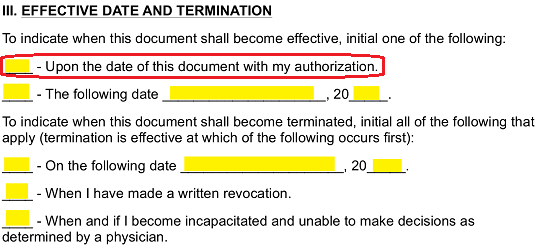 If the Principal would prefer to have a predetermined Effective Start Date, then he or she should initial the blank space just before the words “The following date” then, enter the Date the Principal desires the Attorney-in-Fact’s Principal Power to become effective.
If the Principal would prefer to have a predetermined Effective Start Date, then he or she should initial the blank space just before the words “The following date” then, enter the Date the Principal desires the Attorney-in-Fact’s Principal Power to become effective.  The Principal will be able to convey his or her preferences as to when this document’s Powers terminate. This will require the Principal to read the last three statements in this section then, initial the one that he or she wishes to apply. If the Principal has selected a specific Termination Date for these Powers, he or she should initial the blank space preceding the words “On the following date,” then, enter the Termination Date that should be applied.
The Principal will be able to convey his or her preferences as to when this document’s Powers terminate. This will require the Principal to read the last three statements in this section then, initial the one that he or she wishes to apply. If the Principal has selected a specific Termination Date for these Powers, he or she should initial the blank space preceding the words “On the following date,” then, enter the Termination Date that should be applied. 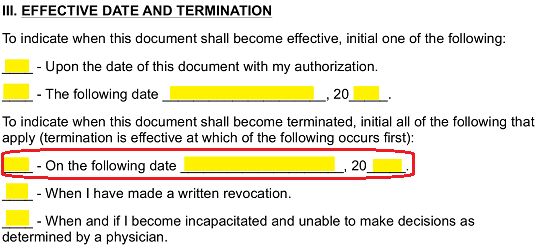 If the Principal only wishes the Powers in this document to Terminate upon a written Revocation (issued by the Principal), he or she should initial the second statement.
If the Principal only wishes the Powers in this document to Terminate upon a written Revocation (issued by the Principal), he or she should initial the second statement.  The Principal may also choose for the Powers in this document to only Terminate if he or she is rendered incapable of making decisions (this must be a written declaration by his or her Physician). If this is the case, the Principal should initial the last statement in this section.
The Principal may also choose for the Powers in this document to only Terminate if he or she is rendered incapable of making decisions (this must be a written declaration by his or her Physician). If this is the case, the Principal should initial the last statement in this section.
5 – The Acknowledgement Signatures Of Several Parties Must Be Supplied
Naturally, since this document can have drastic effects on the Principal’s Life, his or her Signature will be required as proof of the Principal Intent to appoint Principal Authority to the Attorney-in-Fact.
The Principal’s first step in executing this document will be to enter the Date of Signature. Thus, on the day the Principal signs this form, he or she must enter the Calendar Date using the blank spaces after the words “In Witness Whereof…” There will be two blank lines below this statement. The Principal must sign his or her Name on the first one then Print his or her Name on the second one (labeled “Principal’s Signature” and Principal’s Printed Name” respectively”).
There will be two blank lines below this statement. The Principal must sign his or her Name on the first one then Print his or her Name on the second one (labeled “Principal’s Signature” and Principal’s Printed Name” respectively”).  The next party to participate in this document’s execution is the Attorney-in-Fact. Enter the Attorney-in-Fact’s Full Name (as it is reported on the first page) onto the first blank line after the heading “Acceptance of Appointment.”
The next party to participate in this document’s execution is the Attorney-in-Fact. Enter the Attorney-in-Fact’s Full Name (as it is reported on the first page) onto the first blank line after the heading “Acceptance of Appointment.” The Attorney-in-Fact must also Sign and Print his or her Name on the two blank lines under the statement.
The Attorney-in-Fact must also Sign and Print his or her Name on the two blank lines under the statement. 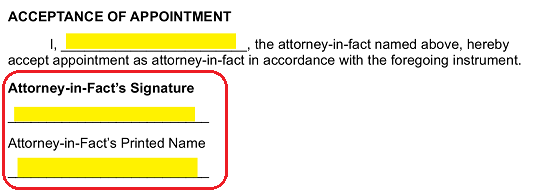 The next Signature required will be that of the Witnesses to the Principal Signature. There will be a paragraph declaring their observance of the Principal Signing and enough room for each one to sign his or her Name then report his or her Address.
The next Signature required will be that of the Witnesses to the Principal Signature. There will be a paragraph declaring their observance of the Principal Signing and enough room for each one to sign his or her Name then report his or her Address.  Finally, the Notary Public obtained to Notarize this document’s execution will supply the items in the “Acknowledgement of Notary Public” section.
Finally, the Notary Public obtained to Notarize this document’s execution will supply the items in the “Acknowledgement of Notary Public” section.